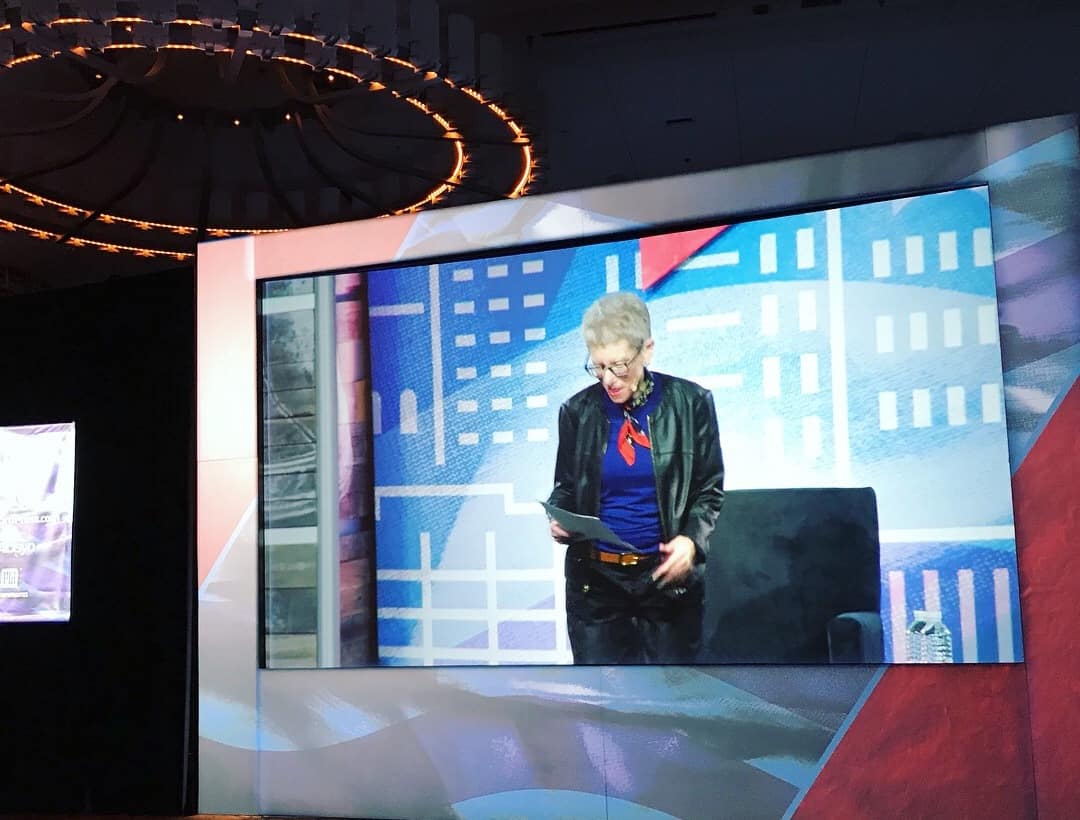Public speaking is Grant Baldwin’s bread & butter w/ homemade strawberry jam. He’s toured the country, billed over $2M+ in speaking fees, and now teaches thousands of others how to do the same. If you enjoy this chat and want to learn MORE about becoming an influencer speaker–your next step is to watch one of Grant’s webinars here. They’re absolutely fantastic.
Listen to my episode with Grant Baldwin from The Speaker Lab
or listen on Apple Podcasts \ Google Podcasts \ SpotifyAll speakers MUST deliver talks with these 2 questions in mind:
A few months back, I got the chance to see a radio legend.
Host of NPR’s Fresh Air: Terry Gross!

I (and everybody else) was so excited to catch her keynote.
The day came, we showed up, Terry came on stage and spoke–and I literally walked out early, disappointed and mystified.
It was odd.
- I listen to her on NPR.
- She’s one of the world’s top interviewers.
- She’s been a character on the Simpsons.
But her keynote fell flat for me. Why?
She failed to deliver on TWO essential questions:
*
Per Grant, these are the two questions every audience is asking–while you’re up there on stage delivering content:
- So what?
- Now what?
“So what?” = Why should I listen to what this speaker is saying?
You must reinforce what your talk is important. Why each point is important.
Why we should care about what you have to say and listen to you.
The audience is asking “ok–so what? Why should I care?”
Answering that is fairly easy once you know you need to do it…
Example:
I’m preparing my own talk for FinCon in Orlando, titled “A dead-simple podcast production system for newbies,” in which I’m sharing time-saving hacks for podcasters and other creators, as well as a guide on producing a “minimum viable podcast” given NO experience.
- Audience: “so what? why should we care.”
- Me: “TIME.”
Lots of people would love to start blogs, podcasts, or create YouTube channels.
But those take an absurd amount of time learning, creating, publishing, marketing, etc, etc, etc.
My talk helps people save massive amounts of time and energy–allowing them to actually take action on and accomplish what they want.
“Because without these time-saving methods–podcasting is going to eat up much of your time” is my answer to “so what?”
Answering “so what” is also important for creating blog posts!
If you want to keep readers engaged, scrolling down the page, opting into your freebies, joining your tribes and becoming REPEAT visitors–you MUST relay to them why they should do so.
What’s in it for them? Why should they keep reading? So what?
Pro Tip: Answer these in your blog post intros 🙂
Always answer the “so what?”
“Now what?” = we’ve listened to (or read) your point, now what do we do?
In Terry’s keynote at Podcast Movement–there was no takeaway.
There was no “if you want to continue learning about how to be a better interviewer or podcast, you should do this next.”
Not even a general call-to-action or “call-to-be-inspired.”
**
Bloggers–you’re probably already familiar with what a CTA is (call to action)–it’s a literal statement of what the reader/audience member should DO next after reading your post, hearing you speak, etc.
The “now what?” answer could be just about anything, as long as you’re actually providing it.
Example:
For my podcasting talk at FinCon, I’m not supposed to do self-promotion, so point people to Online Impact, my own email list, etc, is off-limits.
WAIT how do you give a CTA w/ zero self-promotion???? – all bloggers everywhere.
Easy.
You encourage them to start taking action on their own ideas–being as explicit as possible with WHAT that is and HOW to do it.
Example:
At the end of my speaking gig–I’m going to
- Challenge people to identify the barriers to them starting
- Triple-reviewing the takeaways from my talk that’ll help them destroy those barriers.
- Challenging them to identify the next baby step.
Not the next 17 baby steps to start a blog or podcast–but the next 1 step.
Something they’ll remember when they get home.
3 more quick tips for new speakers:
Grant made a point to emphasize these…
1 – Do not “wing it.”
As much as this seems like “well, duh Pete…” it isn’t.
Be prepared and do your homework. Rehearse!
Honestly–I don’t really need to explain this further–though I do understand how difficult it is to actually put this into practice lol
2 – Expect things to go wrong.
Grant relayed stories of dogs running into the audience, delivering talks in darkness because the power went out.
- Mics not working
- Your slide notes not showing
- The audience is tired because you’re the last speaker of the day
There are a million things that could affect your speaking gig–which you have little to NO control over.
How you deal with this stuff is what separates great speakers from–non-great speakers.
The key is the following:
3 – As a speaker, you’re the thermostat–not a thermometer.
- a thermometer simply reads the temperature
- a thermostat SETS the temperature
You control the atmosphere in the room, and this goes double for when something unplanned happens.
The power goes out and you lose your presentation slides?
The audience is looking to you for their reaction. You set the mood.
Set the temperature for the room. Set the temperature for engagement and learning. That’s your job.
Over to you: is public speaking something you aspire to do?
Comment below and let us know!
What do you want to talk about?


